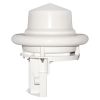Lufft ANACON Analog/Digital Converter
Features
- 2 analogue inputs with 24 bit resolution and signal conditioning
- Functions displayed via LED’s
- Easy mounting on standard EN mounting rails
- Expedited repair and warranty service
- Lifetime technical support
- More
Overview
The Lufft ANACON is an intelligent analog/digital converter with electrical isolation, suitable for integration into UMB networks. The devices are easily installed on standard EN mounting rails and networked together by means of mounting rail bus connectors. The 24V feed for the power supply takes place via the bus connector. Windows software is available for the configuration of the ANACON via RS232 port and an additional ISOCON (8160.UISO).
Mechanics
2 analog inputs with 24-bit resolution and signal conditioning for resistance, PT100/PT1000, voltage, current, frequency, and pulses, as well as pre-defined settings for a large number of Lufft environmental sensors. A half-duplex RS485 interface for networking the converters together.
Benefits
- Easy mounting on standard EN mounting rails
- Easy networking of up to 32 subscribers via mounting rail bus connectors
- 24V DC power supply suitable for switchgear cabinets
- ESD protection for all interfaces
- Configuration via Windows software provided
- Functions displayed via LED’s
- Low space requirement; width approx. 23mm/module
- Low energy consumption/dissipation
In The News
Wildfire Prevention in the Sierra Nevada Region with the Yuba Watershed Institute
Though recent wildfires have sparked new conversations about wildfire management and response, groups like the Yuba Watershed Institute have been monitoring the forests and water resources of the Sierra Nevada region for decades, managing approximately 5,000 acres of land with the Bureau of Land Management (BLM) and about 7,000 acres in private land partnerships. The goal of the Institute is to work with local communities and land agencies to improve watershed and forestry management through informed practices and public outreach. The goals of the Yuba Watershed Institute are three-fold: Improve the ability of fire suppression agencies like the California Department of Forestry and Fire Protection ( CAL FIRE ) and the US Forest Service.
Read MoreWave Sensors Integration with NexSens Buoys: A Cutting-Edge Solution for Wave Measurment
Real-time wave data supports accurate weather prediction, safe and efficient maritime operations, and provides valuable safety and operating condition information for recreation and commercial fishing. Understanding wave dynamics also helps with the design of protective coastal structures like seawalls, breakwaters, and jetties. It also supports better prediction of their impact on sediment transport and coastal geomorphology. Wave data is a key factor in qualifying and designing offshore wind farms and harnessing kinetic energy for electrical generation. It helps with the understanding of ocean-atmosphere interactions and contributes to studies of sea-level rise and climate change impacts.
Read MoreSpring 2025 Environmental Monitor Available Now
In the Spring 2025 edition of the Environmental Monitor, we highlight partnerships across the world and the importance of collaboration between government agencies, universities, environmental groups, local communities, and other stakeholders. From great white shark research in Cape Cod to monitoring fisheries in Lake Erie, this latest edition underscores partnerships that connect stakeholders in a watershed through environmental data. With an emphasis on data sharing, a combination of real-time and discrete sampling keeps the public and partners informed of environmental conditions. Our writers also sought out science professionals dedicated to working with peers within and outside of the environmental sector.
Read More








